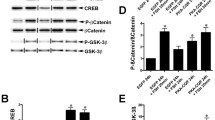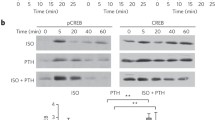Abstract
The mechanisms whereby G protein-coupled receptors (GPCR) activate signalling pathways involved in mRNA translation are ill-defined, in contrast to tyrosine kinase receptors (TKR). We compared a GPCR and a TKR, both endogenously expressed, for their ability to mediate phosphorylation of 70-kDa ribosomal S6 kinase p70S6K in primary rat Sertoli cells at two developmental stages. In proliferating cells stimulated with follicle-stimulating hormone (FSH), active p70S6K was phosphorylated on T389 and T421/S424, through cAMP-dependent kinase (PKA) and phosphatidyl-inositide-3 kinase (PI3K) antagonizing actions. In FSH-stimulated differentiating cells, active p70S6K was phosphorylated solely on T389, PKA and PI3K independently enhancing its activity. At both developmental stages, insulin-induced p70S6K regulation was consistent with reported data. Therefore, TKR and GPCR trigger distinct p70S6K active conformations. p70S6K developmental regulation was formalized in a dynamic mathematical model fitting the data, which led to experimentally inaccessible predictions on p70S6K phosphorylation rate.












Similar content being viewed by others
References
Ohanna M, Sobering AK, Lapointe T, Lorenzo L, Praud C, Petroulakis E, Sonenberg N, Kelly PA, Sotiropoulos A, Pende M (2005) Atrophy of S6K1(−/−) skeletal muscle cells reveals distinct mTOR effectors for cell cycle and size control. Nat Cell Biol 7:286–294
Pende M, Kozma SC, Jaquet M, Oorschot V, Burcelin R, Le Marchand-Brustel Y, Klumperman J, Thorens B, Thomas G (2000) Hypoinsulinaemia, glucose intolerance and diminished beta-cell size in S6K1-deficient mice. Nature 408:994–997
Lane HA, Fernandez A, Lamb NJ, Thomas G (1993) p70S6K function is essential for G1 progression. Nature 363:170–172
Blenis J, Erikson RL (1985) Regulation of a ribosomal protein S6 kinase activity by the Rous sarcoma virus transforming protein, serum, or phorbol ester. Proc Natl Acad Sci USA 82:7621–7625
Stewart MJ, Thomas G (1994) Mitogenesis and protein synthesis: a role for ribosomal protein S6 phosphorylation? Bioessays 16:809–815
Rogers GW Jr, Richter NJ, Merrick WC (1999) Biochemical and kinetic characterization of the RNA helicase activity of eukaryotic initiation factor 4A. J Biol Chem 274:12236–12244
Raught B, Peiretti F, Gingras AC, Livingstone M, Shahbazian D, Mayeur GL, Polakiewicz RD, Sonenberg N, Hershey JW (2004) Phosphorylation of eucaryotic translation initiation factor 4B Ser422 is modulated by S6 kinases. EMBO J 23:1761–1769
Holz MK, Ballif BA, Gygi SP, Blenis J (2005) mTOR and S6K1 mediate assembly of the translation preinitiation complex through dynamic protein interchange and ordered phosphorylation events. Cell 123:569–580
Burnett PE, Barrow RK, Cohen NA, Snyder SH, Sabatini DM (1998) RAFT1 phosphorylation of the translational regulators p70 S6 kinase and 4E-BP1. Proc Natl Acad Sci USA 95:1432–1437
Dennis PB, Pullen N, Pearson RB, Kozma SC, Thomas G (1998) Phosphorylation sites in the autoinhibitory domain participate in p70(s6k) activation loop phosphorylation. J Biol Chem 273:14845–14852
Pullen N, Thomas G (1997) The modular phosphorylation and activation of p70S6K. FEBS Lett 410:78–82
Dennis PB, Pullen N, Kozma SC, Thomas G (1996) The principal rapamycin-sensitive p70(s6 k) phosphorylation sites, T-229 and T-389, are differentially regulated by rapamycin-insensitive kinase kinases. Mol Cell Biol 16:6242–6251
Pullen N, Dennis PB, Andjelkovic M, Dufner A, Kozma SC, Hemmings BA, Thomas G (1998) Phosphorylation and activation of p70S6K by PDK1. Science 279:707–710
Ma L, Chen Z, Erdjument-Bromage H, Tempst P, Pandolfi PP (2005) Phosphorylation and functional inactivation of TSC2 by Erk implications for tuberous sclerosis and cancer pathogenesis. Cell 121:179–193
Proud CG (2007) Signalling to translation: how signal transduction pathways control the protein synthetic machinery. Biochem J 403:217–234
Edelmann HM, Kuhne C, Petritsch C, Ballou LM (1996) Cell cycle regulation of p70 S6 kinase and p42/p44 mitogen-activated protein kinases in Swiss mouse 3T3 fibroblasts. J Biol Chem 271:963–971
Le XF, Hittelman WN, Liu J, McWatters A, Li C, Mills GB, Bast RC Jr (2003) Paclitaxel induces inactivation of p70 S6 kinase and phosphorylation of Thr421 and Ser424 via multiple signaling pathways in mitosis. Oncogene 22:484–497
Suh JM, Song JH, Kim DW, Kim H, Chung HK, Hwang JH, Kim JM, Hwang ES, Chung J, Han JH, Cho BY, Ro HK, Shong M (2003) Regulation of the phosphatidylinositol 3-kinase, Akt/protein kinase B, FRAP/mammalian target of rapamycin, and ribosomal S6 kinase 1 signaling pathways by thyroid-stimulating hormone (TSH) and stimulating type TSH receptor antibodies in the thyroid gland. J Biol Chem 278:21960–21971
Arvisais EW, Romanelli A, Hou X, Davis JS (2006) AKT-independent phosphorylation of TSC2 and activation of mTOR and ribosomal protein S6 kinase signaling by prostaglandin F2alpha. J Biol Chem 281:26904–26913
Moschella PC, Rao VU, McDermott PJ, Kuppuswamy D (2007) Regulation of mTOR and S6K1 activation by the nPKC isoforms, PKCepsilon and PKCdelta, in adult cardiac muscle cells. J Mol Cell Cardiol 43:754–766
Ballou LM, Cross ME, Huang S, McReynolds EM, Zhang BX, Lin RZ (2000) Differential regulation of the phosphatidylinositol 3-kinase/Akt and p70 S6 kinase pathways by the alpha(1A)-adrenergic receptor in rat-1 fibroblasts. J Biol Chem 275:4803–4809
Lecureuil C, Tesseraud S, Kara E, Martinat N, Sow A, Fontaine I, Gauthier C, Reiter E, Guillou F, Crepieux P (2005) Follicle-stimulating hormone activates p70 ribosomal protein S6 kinase by protein kinase A-mediated dephosphorylation of Thr 421/Ser 424 in primary Sertoli cells. Mol Endocrinol 19:1812–1820
Dierich A, Sairam MR, Monaco L, Fimia GM, Gansmuller A, LeMeur M, Sassone-Corsi P (1998) Impairing follicle-stimulating hormone (FSH) signaling in vivo: targeted disruption of the FSH receptor leads to aberrant gametogenesis and hormonal imbalance. Proc Natl Acad Sci USA 95:13612–13617
Kumar TR, Wang Y, Lu N, Matzuk MM (1997) Follicle stimulating hormone is required for ovarian follicle maturation but not male fertility. Nat Genet 15:201–204
Sairam MR, Krishnamurthy H (2001) The role of follicle-stimulating hormone in spermatogenesis: lessons from knockout animal models. Arch Med Res 32:601–608
Wayne CM, Fan HY, Cheng X, Richards JS (2007) Follicle-stimulating hormone induces multiple signaling cascades: evidence that activation of Rous sarcoma oncogene, RAS, and the epidermal growth factor receptor are critical for granulosa cell differentiation. Mol Endocrinol 21:1940–1957
Kara E, Crepieux P, Gauthier C, Martinat N, Piketty V, Guillou F, Reiter E (2006) A phosphorylation cluster of five serine and threonine residues in the C-terminus of the follicle-stimulating hormone receptor is important for desensitization but not for beta-arrestin-mediated ERK activation. Mol Endocrinol 20:3014–3026
Guillou F, Martinat N, Combarnous Y (1986) Study of the superactivity of equine follicle-stimulating hormone in in vitro stimulation of rat Sertoli cells. Biochem Biophys Acta 887:196–203
Bernard L, Martinat N, Lécureuil C, Crépieux P, Reiter E, Tilloy-Ellul A, Chevalier S, Guillou F (2007) Dichlorodiphenyltrichloroethane impairs follicle-stimulating hormone receptor-mediated signaling in rat Sertoli cells. Reprod Toxicol 23:158–164
Guillou H, Lecureuil C, Anderson KE, Suire S, Ferguson GJ, Ellson CD, Gray A, Divecha N, Hawkins PT, Stephens LR (2007) Use of the GRP1 PH domain as a tool to measure the relative levels of PtdIns(3, 4, 5)P3 through a protein-lipid overlay approach. J Lipid Res 48:726–732
Nishio Y, Nagata S, Umeda M, Shirai R, Yokogawa T, Ihara S, Fukui Y (2000) Quantification of phosphatidylinositol 3, 4, 5-trisphosphate by liposome lysis assay with specific monoclonal antibodies. Anal Biochem 285:270–273
Crépieux P, Marion S, Martinat N, Fafeur V, Vern YL, Kerboeuf D, Guillou F, Reiter E (2001) The ERK-dependent signalling is stage-specifically modulated by FSH, during primary Sertoli cell maturation. Oncogene 20:4696–4709
Bortolussi M, Zanchetta R, Belvedere P, Colombo L (1990) Sertoli and Leydig cell numbers and gonadotropin receptors in rat testis from birth to puberty. Cell Tissue Res 260:185–191
Monn E, Desautel M, Christiansen RO (1972) Highly specific testicular adenosine-3′, 5′-monophosphate phosphodiesterase associated with sexual maturation. Endocrinology 91:716–720
Murray AJ (2008) Pharmacological PKA inhibition: all may not be what it seems. Sci Signal 1, re4
Tang X, Wang L, Proud CG, Downes CP (2003) Muscarinic receptor-mediated activation of p70 S6 kinase 1 (S6K1) in 1321N1 astrocytoma cells: permissive role of phosphoinositide 3-kinase. Biochem J 374:137–143
Alam H, Maizels ET, Park Y, Ghaey S, Feiger ZJ, Chandel NS, Hunzicker-Dunn M (2004) FSH activation of HIF-1 by the PI3-kinase/AKT/Rheb/mTOR pathway is necessary for induction of select protein markers of follicular differentiation. J Biol Chem 279:19431–19440
Shaw RJ, Cantley LC (2006) Ras, PI(3)K and mTOR signalling controls tumour cell growth. Nature 441:424–430
Suire S, Fontaine I, Guillou F (1995) Follicle stimulating hormone (FSH) stimulates transferrin gene transcription in rat Sertoli cells: cis and trans-acting elements involved in FSH action via cyclic adenosine 3′, 5′-monophosphate on the transferrin gene. Mol Endocrinol 9:756–766
Sun L, Peng Y, Sharrow AC, Iqbal J, Zhang Z, Papachristou DJ, Zaidi S, Zhu LL, Yaroslavskiy BB, Zhou H, Zallone A, Sairam MR, Kumar TR, Bo W, Braun J, Cardoso-Landa L, Schaffler MB, Moonga BS, Blair HC, Zaidi M (2006) FSH directly regulates bone mass. Cell 125:247–260
Wang L, Proud CG (2002) Ras/Erk signaling is essential for activation of protein synthesis by Gq protein-coupled receptor agonists in adult cardiomyocytes. Circ Res 91:821–829
Kam Y, Exton JH (2004) Role of phospholipase D1 in the regulation of mTOR activity by lysophosphatidic acid. FASEB J 18:311–319
Polakiewicz RD, Schieferl SM, Gingras AC, Sonenberg N, Comb MJ (1998) mu-Opioid receptor activates signaling pathways implicated in cell survival and translational control. J Biol Chem 273:23534–23541
Nechamen CA, Thomas RM, Cohen BD, Acevedo G, Poulikakos PI, Testa JR, Dias JA (2004) Human follicle-stimulating hormone (FSH) receptor interacts with the adaptor protein APPL1 in HEK 293 cells: potential involvement of the PI3K pathway in FSH signaling. Biol Reprod 71:629–636
Nechamen CA, Thomas RM, Dias JA (2007) APPL1, APPL2, Akt2 and FOXO1a interact with FSHR in a potential signaling complex. Mol Cell Endocrinol 260–262:93–99
Ferrari S, Bannwarth W, Morley SJ, Totty NF, Thomas G (1992) Activation of p70S6K is associated with phosphorylation of four clustered sites displaying Ser/Thr-Pro motifs. Proc Natl Acad Sci USA 89:7282–7286
Duncan R, McConkey EH (1982) Rapid alterations in initiation rate and recruitment of inactive RNA are temporally correlated with S6 phosphorylation. Eur J Biochem 123:539–544
DeWire SM, Kim J, Whalen EJ, Ahn S, Chen M, Lefkowitz RJ (2008) Beta-arrestin-mediated signaling regulates protein synthesis. J Biol Chem 283:10611–10620
Acknowledgments
The authors thank the technical assistance of the rat breeders Jean-Claude Braguer and Claude Cahier. Drs Florian Guillou, Laurence Dupuy in our laboratory, and Drs François Fages and Frédérique Clément (INRIA, Rocquencourt), are acknowledged for critical reading of the manuscript. We are also indebted to Drs Len Stephens and Phil Hawkins for the PIP3 quantification and to Dr Anne Segonds-Pichon for statistical analysis (Babraham Institute, Cambridge, UK). A.M. was funded by a fellowship from the Region Centre and from the Institut National de la Recherche Agronomique (INRA), D.H. was funded by a fellowship from the INRA (ASC), G.D. by a fellowship from the Ministère de la Recherche et de la Technologie, C.L. was granted by the Fondation pour le Recherche Médicale, and H.G. was a BBSRC fellow. This work was supported by the INRA AgroBI AIP, by the Centre National de la Recherche Scientifique, by Université de Tours and by the AE INRIA/INRA REGATE.
Author information
Authors and Affiliations
Corresponding author
Rights and permissions
About this article
Cite this article
Musnier, A., Heitzler, D., Boulo, T. et al. Developmental regulation of p70 S6 kinase by a G protein-coupled receptor dynamically modelized in primary cells. Cell. Mol. Life Sci. 66, 3487–3503 (2009). https://doi.org/10.1007/s00018-009-0134-z
Received:
Revised:
Accepted:
Published:
Issue Date:
DOI: https://doi.org/10.1007/s00018-009-0134-z




